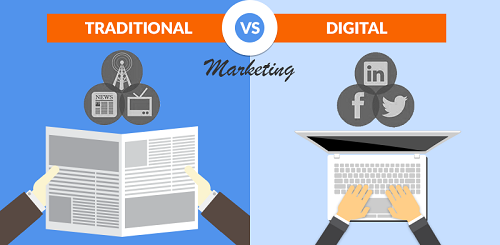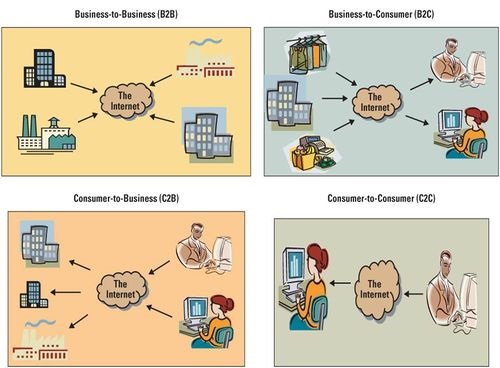Long gone and forgotten are the days when commercial activities such as exchange of goods and services for money, between two parties, had to take place in a traditional setting. The customer going to the marketplace, checking out a variety of products, choosing required stuff, purchasing them and then paying the specific amount is what marks traditional commerce. However, nowadays with technology innovations, modern ways of selling goods and services have come up. For instance, e-commerce, where people buy and sell products via the Internet.
Even with the advent of e-commerce, some people prefer traditional commerce because they think that e-commerce is not safe. However, both methods are reliable to use. The focus of this article is to discuss the differences between traditional and e-commerce. But before that, we need to understand how these modes of goods and services exchange work.
What is Traditional Commerce?
Traditional commerce involves the exchange of goods and services between two people face to face. Like mentioned in the introduction, it is one of the oldest modes of buying products and services. It is done by almost everyone all over the globe. Just walking into a store or a marketplace, selecting an item and paying for the product.
Traditional Commerce is part of a business that involves all the activities that expedite business. The main two kinds of actions include trade and trading auxiliaries. Trading is, of course, the buying and selling of goods and services for money. Trading auxiliaries refer to business-related activities such as banking, transportation, insurance, packaging, marketing and advertisements, and more. Auxiliaries focus on helping to achieve successful business transactions between any two trading parties.
More on traditional commerce is that it includes all the activities that make straightforward goods and services exchange from the manufacturer to the consumers. Production of goods does not reach the consumer directly. Reasonably it passes various activities included in commerce. Traditional commerce depends on routine business operating hours during a specified period. It also requires occupying a retail store and housing inventory.
Business transactions mostly face to face interactions with customers. For new and repeat business, traditional commerce thrives on word of mouth, customer referrals, and networking. For business success, personal communication is, therefore, a key factor when relying on traditional commerce. Many businesses that trade their goods and services like this network within the society establish relationships with town leaders, chambers of commerce and also sponsor local sports teams and events to attract business and develop relationships within the community.
What is Ecommerce?
Ecommerce also electronic commerce is like traditional commerce. As such, it also involves the exchange of goods and services. The only difference is that it is conducted online via an electronic network – the Internet. Nowadays it has extended to online social networks. With e-commerce, transactions, assistance, and communication are done through the use of the electronic medium. All business activities including selling, ordering, purchasing, payments are performed over the internet. Technologies such as electronic data interchange, email, and electronic fund transfers are used for transactions and payments. E-commerce can be further categorized as follows:
- B2B commerce: occurs when the business transactions take happen between two business enterprises via electronic means
- B2C commerce: occurs when there is exchange of goods and services between a business and the customer via the internet
- C2C commerce: takes place when the buying and selling of products and services occurs between customers using electronic channels
- Intra-B commerce: happens when the exchange of goods and services takes place within a business enterprise via electronic medium
Differences between Traditional Commerce and E-commerce
There are major differences between traditional and e-commerce. Below are some of the fundamental differences
Exchange of Traditional Commerce and E-Commerce :
Traditional commerce focuses on the exchange of products and services through personal interactions and is therefore manual while e-commerce trading activities are online via the internet and can be considered automatic
Timing of Traditional Commerce and E-Commerce :
Traditional commerce is limited to time business hours mostly during the day while e-commerce is 24/7, it can be done anytime day and night
Physical Interaction in Traditional Commerce and E-Commerce :
Traditional commerce allows a buyer to be physical inspect goods and test out services before making a purchase. Conversely, with e-commerce, products and services are not examined physically.
Face to Face :
As far as consumer interactions are concerned, traditional commerce provides face to face. On the other hand, e-commerce can be termed as screen to face interaction.
Geographical location:
Traditional commerce is limited to a particular geographical location while e-commerce is global and has no physical limitation.
Platform in Traditional Commerce and E-Commerce:
With traditional commerce, there’s no uniform platform for information exchange. Contrariwise, e-commerce has a unique uniform platform for exchanging information
Business relationship:
Business relationships with conventional commerce is linear while with e-commerce it is end to end.
Marketing in Traditional Commerce and E-Commerce:
When it comes to marketing, traditional commerce takes on a one-way marketing approach. E-commerce, on the other hand, takes on a one on one marketing strategy.
Payment involved in Traditional Commerce and E-Commerce:
Modes of payment in traditional commerce include cash, cheques, and credit cards. With e-commerce, there’s electronic funds transfer, credit card numbers and more.
Delivery:
Good and delivery of services is instant with traditional commerce while e-commerce delivery takes some time.
Establishment of Traditional Commerce and E-Commerce:
It is difficult to establish and maintain standard practices in traditional commerce. However, with e-commerce, uniform strategies can be quickly established and maintained.
Here’s a summarized chart on the differences between traditional and e-commerce:
Comparison Feature |
Traditional commerce |
E-commerce |
| Definition & Meaning | Traditional commerce focuses on the exchange of products and services through personal interactions | E-commerce focuses on the exchange of goods and services via the Internet
|
| Accessibility | Limited to several hours during the day | Can be accessed anytime 24/7 |
| Customer Interface | Customers interact with business face-face | Customers use computing devices to access and interact with business |
| Business Scope | Geographically limited to business location | Global business scope |
| Mode of Delivery | Instant | Time-consuming |
| Transaction Processing | Manual | Automatic |
| Product Physical Inspection | Can be done before purchase | Cannot be done before purchase |
| Mode of Payment | Cash, Credit Card, Cheques | No Cash, Credit card, Wire Transfer, |
Summary of Traditional Commerce and E-commerce
Following the discussion above, both traditional and e-commerce are modes of exchanging goods and services. Each has its pros and cons. e-Commerce is like conventional commerce with the major difference being the platforms via which the exchange and business transactions occur. E-commerce saves consumers a lot of time and is therefore convenient because you can buy goods and services in the comfort of your home or just from anywhere at any time. Traditional commerce works in such a way that you have to take time and go to the place/ store where goods and services are stocked hence consuming a lot of time.
E-commerce is not appropriate for perishable goods, and high-value items, so traditional commerce is the one that can better work with such. On the other hand, it is not suitable for software or music purchases. Hence, both modes are needed in the market today.
- Difference between Traditional Commerce and Ecommerce - February 16, 2018
- The Differences between Copay and Deductible - February 6, 2018
- Differences between Personal Property and Real Property - January 29, 2018




Wow this is a very vital information, it has rely helped me a lot. Thanks. I love it.
Reply
Thank you so much it helped me in my eleventh hour preparation
Reply
Amazing Tips Sir Thank You for sharing this awesome post.Really amazing tips thanks for guiding me
Reply